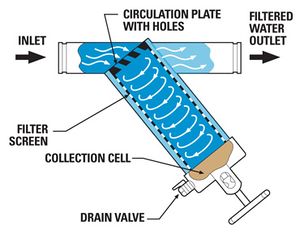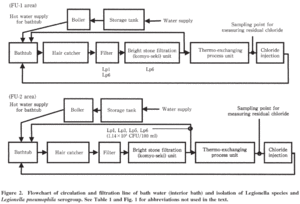Circulation Filters
The circulation filter has been designed and made to meet the highest requirements as to quality and finish. The uniqueness of this filter resides in the fact that the filter element is cleaning itself constantly, the deposit being collected in a built-in chamber. The collecting chamber can be emptied during operation by automatic activation of the flush valve.
Working principle
The model shows the principle of operation of the circulation filter. The water passes a perforated plate with 6 obliquely drilled-in holes. This results in the circular water movement which brings about a constant cleaning of the filter gauze. Impurities are carried in the direction of the flush valve. For this reason the filter body must be installed pointing downwards. The collected dirt can be discharged through a manual or automatic (3/4”) drain valve.
Installation
When installing the filter, pay particular attention to the correct direction of the water flow (inlet/outlet) as indicated by the arrow on the filter. The filter body points downwards; if this position is not possible, the filter body may be placed at an angle of up to 45°. The flush valve must be located on the underside of the filter. If there is a risk of water flowing back, install a quick-acting (mechanical) check valve. A pressure relief valve must be installed before the filter if the pressure is not sufficiently under control. When installing more than one filter, allow enough room between the units for easier maintenance. The maximum working pressure is up to 8 bar. The filter is designed to withstand a maximum pressure of 10 bar.
Maintenance
Each filter comes with these maintenance, installation and operating instructions. Check the element every 2-3 weeks for damage; if damaged, replace it immediately. Apply a film of grease on the thread of the spindle of the handle or on the bolts. Any damage to the protective coating must be repaired immediately. Before applying the protective paint, the damaged spot must be cleaned thoroughly using a steel wire brush.
Advantages
- Separation of water and dirt using flow energy.
- Large dirt-discharging capacity at minimal loss of flushing water.
- Well-adjusted inflow keeps the filter element clean.
- The flow velocity can be optimized by removing or adding plugs.
- Discharging dirt can be automated in a simple manner.
Video

